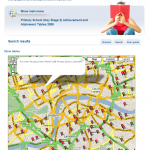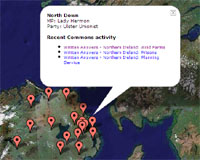He’s at it again. Now environment minister David Miliband is recording video-blog pieces on station platforms, and posting them on YouTube. Blog entry is here, his YouTube profile is here, and his first video is here.
-
School league table map mashup: a breakthrough for e-government
Today’s publication of the new primary school ‘league tables’ hasn’t had huge amounts of media coverage; arguably because there’s too much other political news going on (the US Iraq report, Blair’s trip to Washington, yesterday’s Pre-Budget Report, etc). Cynics might suggest the timing is less than coincidental, since the story’s top line (as reported by the Beeb) is a missed government target.
 But the publication of the new league table data on the Department for Education and Skills website is a bit of an e-government breakthrough. Oh, and let’s get this out of the way: it’s mostly my fault. 🙂
But the publication of the new league table data on the Department for Education and Skills website is a bit of an e-government breakthrough. Oh, and let’s get this out of the way: it’s mostly my fault. 🙂The big leap forward is the use of Google Maps, in what (I think) is government’s first attempt at a ‘mashup’. Type in your postcode and a distance in miles, and you’ll see a good-sized Google Map showing your location, and all the primary schools in the immediate vicinity, as pointers on the map. Click on a pointer to see the school’s name, and click again to see its numbers. (Each school’s page also includes a mini-map, which is still click-and-draggable.)
We also did some nice things in terms of the presentation. If you choose to browse by region, then by local authority, you’ll see all the schools in that authority area as a big table… with some nice rollover effects on both rows and columns. Rows was easy; but as anyone with any HTML knowledge will know, columns is a bit trickier. 😉
 Of course, now it’s live, I’m left thinking about the extra things I wish I could have done, if time and budgets hadn’t been a factor. There are a few rough edges, and it’s not in true ‘house style’ (since it was coded months before the departmental rebrand). I’d like to have kept the various table headers fixed, and scrolled only the data rows. Of course, the ability to sort the data would have been brilliant for the end users – but we weren’t allowed to do that for political reasons.
Of course, now it’s live, I’m left thinking about the extra things I wish I could have done, if time and budgets hadn’t been a factor. There are a few rough edges, and it’s not in true ‘house style’ (since it was coded months before the departmental rebrand). I’d like to have kept the various table headers fixed, and scrolled only the data rows. Of course, the ability to sort the data would have been brilliant for the end users – but we weren’t allowed to do that for political reasons.Personally, I think the mapping brings a whole new dimension to the data, helping me consume quite a large amount of data within a (geographic) context I understand. No apologies for using Google Maps, as opposed to Ordnance Survey: I’m afraid the free functionality, and its ease of use, was too good to refuse. We played by the Web 2.0 rulebook, rather than the public sector conventions, and I think it paid off big-time. But I’d love to know what other people think.
-
Speculation rife as Ordnance Survey CTO quits
Interesting gossip over at Techcrunch UK about the departure of Ordnance Survey‘s Chief Technology Officer, Ed Parsons. There’s really no arguing with the statement that Ordnance Survey missed the ‘web 1.0’ boat, and it isn’t showing any signs of catching the second wave either. Techcrunch say:
we gather from sources that it may have been because he was interested in rocking the boat at Ordnance Survey, especially over its Web 1.0 attitude to sharing data with outside firms, and his declared interest in the free data debate.
If you’re looking for evidence that this is a man on the web 2.0 wavelength… er, have a look at this. Says it all. As one who has faced similar trials and tribulations, trying to kick a public sector dinosaur into shape, I know what you’re going through, Ed. Drop me an email if you fancy a beer.
-
Public sector's own YouTube goes live
PublicTV, produced by Ten Alps, has activated a beta version of its website promising ‘fast and free access to
high quality government, public sector, professional training, and business videos’. In practice, what that seems to mean is a repository for public sector organisations to host and stream video content. Yes folks, it’s YouTube for public information films. Gulp.
The site promises free encoding, hosting and streaming for content suppliers; and will happily accept enquiries from public sector organisations wanting to commission video… which hints at their principal business model. Ten Alps themselves are principally a production company, and by reducing the cost and complexity of hosting, they’re presumably hoping to generate revenue around the content itself. Heaven knows, media budgets in government tend to be more generous, and less closely monitored, than in the commercial world.
There’s an encouragingly broad selection of short films to choose from, even in these early days, delivered in a combination of Flash and Windows Media formats. Clearly taking a cue from YouTube, you can comment on what you see, generate playlists, and see what everyone else is watching. You can’t fault the production values; much better than one would probably expect from within government, and delivered on time too.
There’s more than enough video material sloshing round Whitehall and its environs to keep the site ticking over. Whether there’s much demand for it is another matter.
-
Protopage: a model for News 2.0?
I’m really impressed by the enhancements to Protopage.com – and although I still haven’t made the big decision to make it my default homepage, I’m beginning to understand why these ‘personalised start pages’ are generating such a buzz.
Google does it, Microsoft does it, Yahoo has done it for ages. The Paris-based Netvibes is (or certainly was) the leading upstart start-up in the field. But I find myself warming most to Londoners Protopage, and it might just be a question of the presentation. I love the way you can set a photograph as your ‘wallpaper’, just like on your PC. I love the way it handles thumbnails from Flickr feeds (etc). It’s nice to be able to configure all the colour settings, just how you want them – and lots of colour gradients… mmm, nice. Putting several RSS feeds in one box is cool too. Others – I’m thinking of Netvibes in particular – look more powerful, but feel too cold.
Protopage seems to understand that the key word here is ‘personal’. It needs to feel friendly. If you haven’t played around with any of these services, I highly recommend Protopage. Oh, and if you’ve never seen a site which lets you ‘drag and drop’ stuff around the page, you will be blown away. Brace yourself.
So here’s the radical thought. I don’t think this business is going to go away… too much big-player involvement, too many RSS feeds to aggregate. So maybe the big publishers, media and government, should be looking at how they can get into it too?
There are already early moves in the US, as social media guru Steve Rubel notes. Sports channel ESPN lets you build your own page, including (by the look of it) only-use-it-here feeds, and lets you theme it according to your favourite team. There are nascent efforts at the New York Times and Wall St Journal. (You’ll have to register to test them, sadly.)
I’ve mentioned here before that Sky News is getting a long overdue relaunch next year… and maybe it should be along these lines. 1024×768 screen resolutions give plenty of space to play with. How about a big picture-led treatment of the lead story, headlines and summaries for the ‘second tier’, a few features from the correspondents, and a couple of ‘image galleries’ showing expandable thumbnails. And then, crucially – let people manipulate it. Change the colour, change the wallpaper, add their own local weather, add their own RSS feeds. If we’re happy to accept user-generated content, why not user-generated sub-editing too?
And what should government do? Simple… RSS, and lots of it. I find it staggering how few government departments are pumping out RSS, a technology which is embarrassingly simple to implement, and costs zero pounds extra to run on top of your existing CMS work.
-
New government blogs: food safety and geography
It’s been some time coming, but details are emerging of the second phase of the Hansard Society’s Digital Dialogues programme. Included are a couple of new government blogs launched in the past fortnight: one at the Office for National Statistics, the other at the Food Standards Agency.
As mentioned previously, I spent a couple of difficult years at National Statistics, so I’m delighted to see them dipping their toe in the ‘social media’ water, albeit on a small scale for now. The geographers were always among the most forward-thinking people in the department, and onsgeography.net is going to be an interesting example to observe, stimulating debate around a specific project. A widely accepted approach to geography is crucial in making ONS data more usable to the nation generally, and I hope they can generate good buy-in through this open initiative.
The blog over at the Food Standards Agency is your more familiar personality-led affair, from its chief scientist Andrew Wadge. He promises ‘to let you know what I and my scientist colleagues at the Agency are up to, what the emerging issues are, and how we propose handling them’. If you’re in the business, this could become a great way to keep in touch with FSA activity.
The two blogs share a common layout, and look to be based on a bespoke platform by Bedford-based developers Vohm, who have already worked with the Hansard Society on various projects. It’s all very familiar blogging fare, including RSS feeds, pretty URLs and tag clouds… although I’m curious as to why they haven’t used a standard platform like WordPress.
-
My latest mashup: on Westminster and web services
 I’ve been experimenting a bit more with Ajax, XML and all that good stuff… and have come up with a Google Map of all UK MPs. Each constituency is shown as a marker on the map, grouped by the usual UK government regions to make it a bit more manageable. Click on a marker, and you’ll get the usual Google popup window, telling you who the MP is, which party they’re from… and what they’ve been up to recently. Technically, it’s much the same as last week’s football news mashup. The coordinates for each marker are stored locally in XML files, and all the data is brought in dynamically via ajax (as XML or RSS) when the marker is clicked.
I’ve been experimenting a bit more with Ajax, XML and all that good stuff… and have come up with a Google Map of all UK MPs. Each constituency is shown as a marker on the map, grouped by the usual UK government regions to make it a bit more manageable. Click on a marker, and you’ll get the usual Google popup window, telling you who the MP is, which party they’re from… and what they’ve been up to recently. Technically, it’s much the same as last week’s football news mashup. The coordinates for each marker are stored locally in XML files, and all the data is brought in dynamically via ajax (as XML or RSS) when the marker is clicked.The magic ingredient is the use of the web services API offered by TheyWorkForYou. If you’ve never seen the site before, it takes the official record of proceedings in the House of Commons (Hansard) and turns it from this into this. That’s clever enough in itself, but they go one step further – by offering much of the information for consumption by other websites, in the form of data feeds (including XML). What this means, in practice, is that my humble little map doesn’t know who the individual MP is… but it knows how to ask TheyWorkForYou, and how to process the response. Think of it as cross-site content management: writing once, using many times, even on different websites.
With more than a decade of e-government experience behind me, the recurring thought in my mind is: I’ve thrown this together in a matter of a couple of days. How long would it have taken, how many levels of management would I have had to sweet-talk, and how much would it have cost, to do this inside the public sector? And deep down, I know the answer is that more likely than not, it simply couldn’t happen.
Depressingly, I’m wondering if e-government should throw in the towel, and shift its focus from producing websites to producing web services. In other words, create databases visible to the outside world, and let others do the presentation. Lots of tailored front-ends for different audiences and different uses, all running off the same authoritative data source. I bet we would end up with a better appreciation for the data, and better application of it… which, ultimately, meets government’s objective.
-
Have you seen this offender?
Britain now has its own ‘Most Wanted’ list of child sex offenders who have failed to comply with notification requirements – although claims that it’s on a ‘nationwide scale’ are rather undermined by the fact that the site lists just five individuals, albeit from different parts of the country.
If you see someone you recognise (and well done if you do, given the poor image quality), you’re asked to phone Crimestoppers or the local police force in question… or there’s an email contact form which promises that ‘all information is submitted over a encrypted connection’. I’ll take their word for that, but I don’t immediately see any evidence of a secure connection.
How much use will this be? Well, being realistic, how many members of the public are going to drop by this website every now and again, on the off-chance they might see someone they recognise? And there’s no RSS feed to alert you to new ‘subjects’. I’m getting really depressed by the number of new government websites which don’t feature RSS from day one. Come on, guys – we can do better.
-
Downing St launches e-petitions site
This really is fantastic. ‘Downing Street is working in partnership with the non-partisan charitable project mySociety to provide a service to allow citizens, charities and campaign groups to set up petitions that are hosted on the Downing Street website, enabling anyone to address and deliver a petition directly to the Prime Minister.’ Don’t underestimate the implications here. This isn’t just government allowing others to comment on its ideas; this is a government website actively encouraging people to tell government what to do.
(It isn’t unique, of course: the Scots have had a similar system for some time, and of course there are quite a few independent initiatives out there. But this is Downing Street we’re talking about.)
I’m most interested by the fact that it’s been done by mySociety, an external body who do it for the love of it. Their great work proves that it is possible… and it embarrasses the official e-government channels, who spend millions and don’t even come close to something like theyworkforyou.com. I’m gradually coming to the conclusion that the only way to really deliver change in the public sector is via such guerilla tactics.
-
Scots trump Miliband's podcast initiative
First the blog, then the infamous wiki… now David Miliband is getting into the podcasting game. He’s doing a series of short down-the-line interviews with The Guardian, from the UN’s climate change conference in Kenya. As ever, Miliband comes across very well, keen to engage with the general audience (helped, it must be said, by a fairly soft interviewing style). The audio files are MP3s in moderate quality only, fair enough given the poor quality of the phone line from Nairobi.
I can’t help feeling a bit uncomfortable with the ‘podcast’ label. It’s a series of standard journalist-with-minister interviews, which wouldn’t be the slightest bit remarkable if they were done on a radio programme. But the distribution via MP3 and RSS, through a non-broadcaster (in the traditional sense) gives it some novelty value.
Ross Finnie, the environment minister in the Scottish Executive, sees his audio and raises him some video, though. Granted, it’s a scripted piece-to-camera, less than two and a half minutes – and filmed before he left. But it’s good to see these early attempts at video nonetheless.